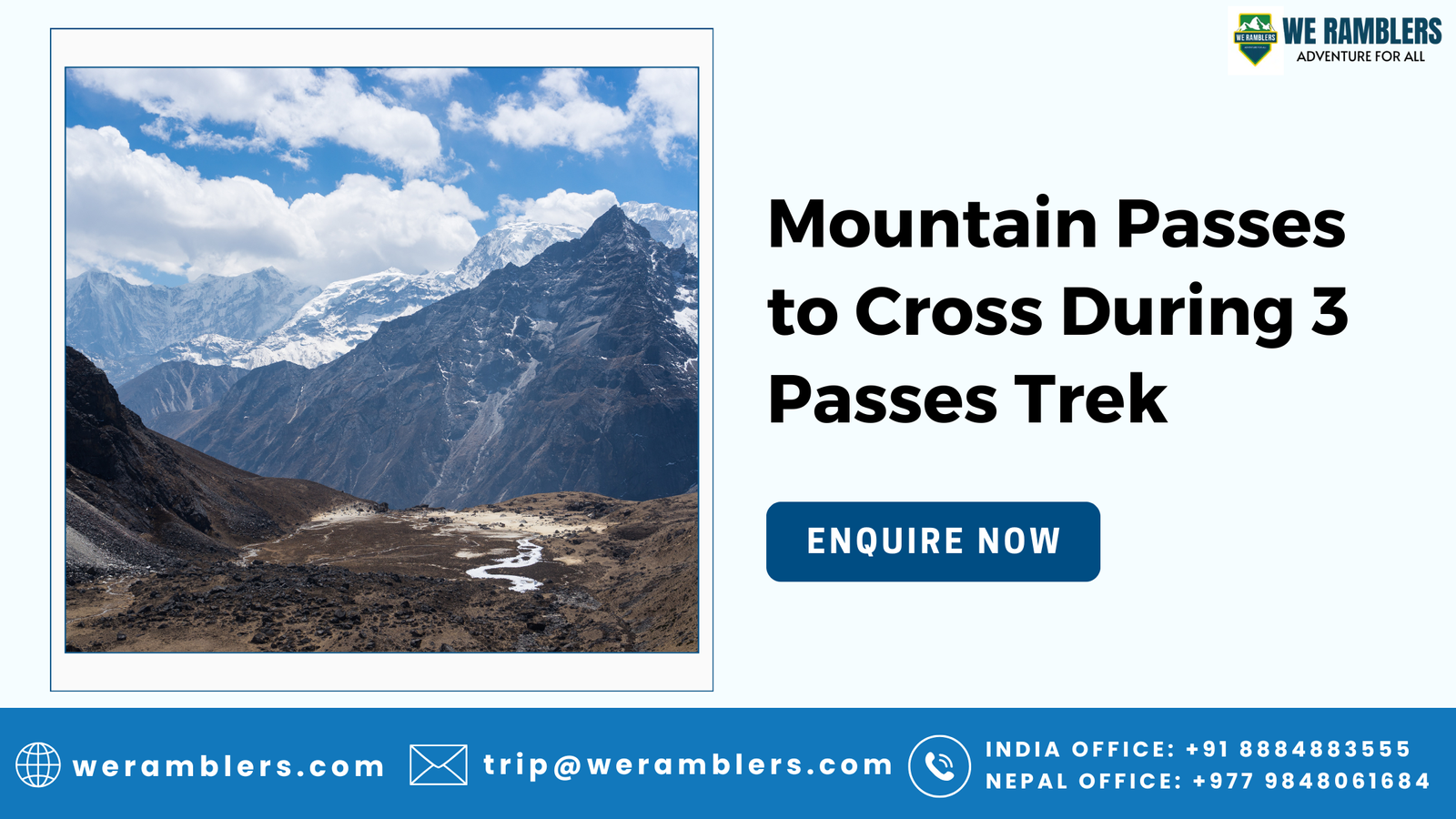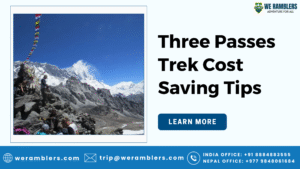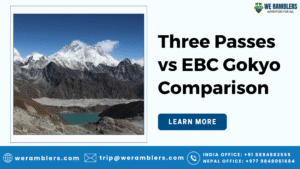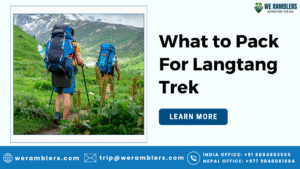Mountain Passes to Cross During 3 Passes Trek – A Complete Guide for Trekkers
The Mountain Passes to Cross During 3 Passes Trek are among the most breathtaking and challenging in the Himalayas, attracting adventure enthusiasts from all over the world. This legendary trek combines high-altitude adventure with spectacular scenery, taking you over Kongma La Pass, Cho La Pass, and Renjo La Pass — three of Nepal’s most iconic crossings.
From snow-clad ridges to glacial landscapes, the trek is a true test of endurance and determination. Each pass offers a unique perspective, whether it’s standing above the Khumbu Glacier, gazing over the Gokyo Lakes, or witnessing the sunrise over Mount Everest. For safety and to meet local regulations, you must be accompanied by a certified trekking guide throughout this journey.
Overview of the 3 Passes Trek
The Three Passes Trek weaves through the heart of the Khumbu region, offering a circuit route that links Everest Base Camp, Gokyo Valley, and Thame Valley.
Trekkers can take the clockwise route starting from Namche Bazaar and moving towards Kongma La, or the counter-clockwise option beginning with Renjo La Pass.
Along the way, you’ll pass through charming Sherpa villages, visit ancient monasteries like Tengboche Monastery, and walk amidst towering peaks including Lhotse, Ama Dablam, Cho Oyu, and Makalu. The trek spans around 18–21 days, depending on acclimatization days and side trips.
Since the trek traverses Sagarmatha National Park, trekkers must obtain the Sagarmatha National Park Permit and Khumbu Pasang Lhamu Rural Municipality Permit.
The 3 Passes Trek is considered strenuous due to its altitude profile, reaching over 5,000 meters on three separate occasions. But for those prepared, it’s the ultimate Himalayan adventure.
Kongma La Pass (5,535 m) – The Highest of the Three
Where It Is
Kongma La Pass lies between Chhukhung and Lobuche, making it the highest and most demanding of the three passes. It’s usually crossed after a night in Chhukhung, giving trekkers a head start for the steep ascent.
Why It’s Special
At the top, trekkers are rewarded with awe-inspiring views of Makalu, Lhotse, and the vast expanse of the Khumbu Glacier. The trail here feels truly remote, with barely any signs of human habitation.
Challenges
- Steep ascents and descents with rocky and often snow-covered paths
- No teahouses or water sources along the crossing day
- Thin air and exposure to the elements make acclimatization essential
Tips
- Start early to avoid afternoon weather changes
- Carry enough water and snacks, as there are no facilities en route
- Have your camera ready for panoramic shots of Himalayan giants
Cho La Pass (5,420 m) – Gateway to Gokyo Valley
Where It Is
Cho La Pass connects Dzongla with Thagnak and acts as the bridge between the Everest Base Camp route and the Gokyo Valley.
Why It’s Popular
The crossing offers dazzling views of Ngozumpa Glacier, the longest glacier in the Himalayas, as well as glimpses of the turquoise Gokyo Lakes.
Challenges
- The ascent can be icy and slippery, especially in colder months
- Rockfalls and loose gravel in some sections
- Glacier crossing requires steady footing and caution
Tips
- Trekking poles are very helpful for stability
- Crampons or microspikes can make the icy sections safer
- Stay hydrated to combat altitude effects
Renjo La Pass (5,360 m) – The Scenic Final Pass
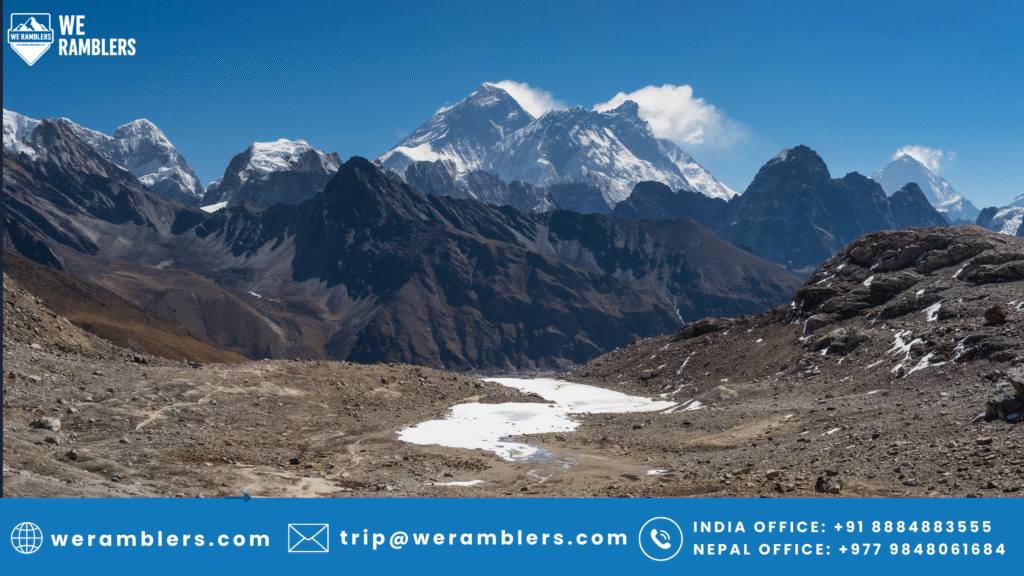
Where It Is
Situated between Gokyo and Lungden, Renjo La Pass is often the final crossing on the 3 Passes circuit.
Why It’s a Favorite
From the top, you can enjoy perhaps the best panoramic view in the Everest region, with Everest, Makalu, Cho Oyu, and the shimmering Gokyo Lakes all in one frame. The sunrise here paints the peaks in golden light, a sight that stays with trekkers forever.
Challenges
- Less steep than Kongma La but still demands stamina
- Cold winds near the summit ridge
- Descent towards Thame Valley can be long and tiring
Tips
- Start before dawn to catch the sunrise over Gokyo
- Dress in layers to adjust for changing temperatures
- Take breaks to savor the views rather than rushing through
Best Time to Do the 3 Passes Trek
The most suitable seasons for the Three Passes Trek are:
- Spring (March–May) – Clear skies, blooming rhododendrons, stable weather
- Autumn (September–November) – Crisp air, best mountain visibility, pleasant daytime temperatures
Monsoon months (June–August) bring heavy rain, leeches, and poor visibility, while winter (December–February) can cause heavy snow accumulation, making passes impassable.
Preparation & Safety Tips
- Train for endurance: Cardiovascular fitness, leg strength, and trekking experience help enormously
- Pack for varied conditions: Layered clothing, down jacket, gloves, and waterproof gear
- Acclimatization is key: Include rest days at Namche Bazaar and Dingboche
- Stay with a certified trekking guide for route safety, emergency assistance, and navigation
- Hydration & nutrition: Carry snacks, drink plenty of water, and avoid overexertion
- AMS awareness: Know the symptoms and act early
We Ramblers – Your Trusted Travel Partner for Everest 3 Passes Trek
We Ramblers is a trusted adventure travel company specializing in guided treks across Nepal’s Himalayas. With years of experience leading groups through challenging routes like the Everest 3 Passes Trek, our team ensures both safety and an enriching travel experience. We focus on sustainable trekking practices, authentic cultural interactions, and expert guidance to make your journey memorable and worry-free.
Frequently Asked Questions (FAQs) About Mountain Passes to Cross During 3 Passes Trek
1. What is the difficulty level of the 3 Passes Trek in Nepal?
The Three Passes Trek is rated as strenuous. It involves multiple days above 5,000 meters, steep ascents and descents, and remote terrain. Physical fitness, prior trekking experience, and proper acclimatization are essential.
2. Do you need permits for the Everest Three Passes Trek?
Yes. You need a Sagarmatha National Park Entry Permit and a Khumbu Pasang Lhamu Rural Municipality Permit. These can be arranged through trekking agencies like We Ramblers.
3. How long does it take to complete the 3 Passes Trek?
Most itineraries take 18–21 days, depending on your chosen route, acclimatization days, and side trips like Everest Base Camp or Gokyo Lakes. Contact us now for the full trek itinerary.
4. Which pass is the hardest in the Three Passes Trek?
Kongma La Pass is generally considered the toughest due to its height (5,535 m), steep trail, and lack of facilities along the way.
5. Can beginners attempt the Everest 3 Passes route?
While not impossible, this trek is better suited for experienced trekkers due to its difficulty. Beginners should prepare extensively and always go with a certified trekking guide.

